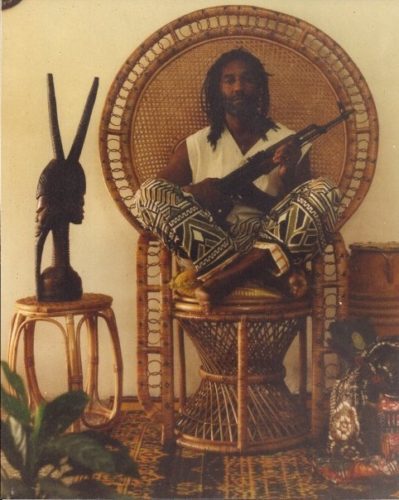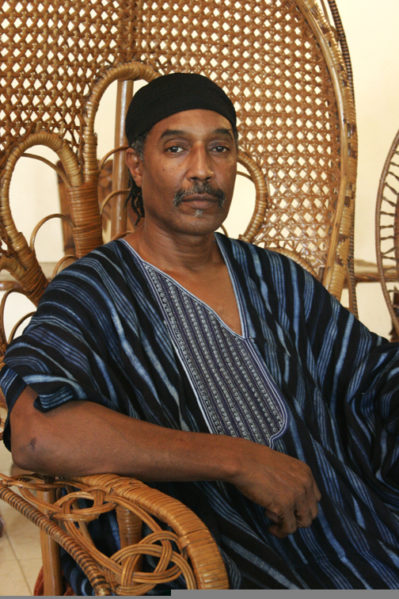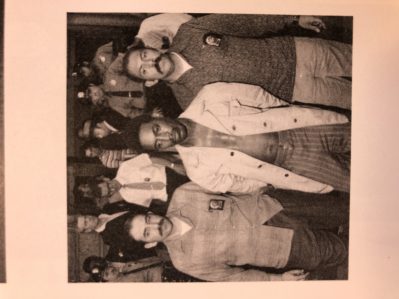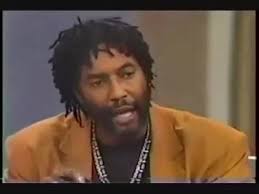Around 1995 in a place unknown, a photo of Dhoruba bin Wahad sitting in a rattan chair holding an AK-47 was taken by an unknown photographer.
Although this is an important remix van Huey P. Newton in a rattan chair, the origin and intention of the image is more obscure to find. In this post you can read what we found and which conclusion we draw. If you have more information about the image, please contact us.
This image was found on various sites (e.g. here and a remix on Dhoruba’s official site), but these sites do not provide any information about the date, place, photographer or meaning behind the image. From the book ‘Black against Empire: The History and Politics of the Black Panther Party’ by Joshua Bloom and Waldo E. Martin, we know that Dhoruba bin Wahad was part of the New York chapter of the Black Panther Party, was one of the New York 21 (see more below) and that he was expelled from the Party by the Central Committee in Oakland (led by Newton) in February 1971, after he jumped bail. We can assume that the personal relationship between Dhoruba and Huey Newton was tense at that moment. And perhaps this appropriation of ‘Huey Newton in a rattan chair’ is a critique on the cult of Huey as the iconic leader. Or perhaps, as Dhoruba’s remix focusses much more on African heritage and ‘cultural nationalism’ -as seen through the clothes, African artefacts-, and in that way improves the original. We maybe it is a hommage to Huey and the seminal role this image played in spreading the message of the Black Panther Party.
We do not know (yet, but we will try to find out). But it helps to find out when this image is taken. We first assumed that this image was used directly after Dhoruba (and many more from the New York 21) were expelled from the Black Panther Party by the Central Committee, headed by Huey P. Newton. As a poster for the newly founded Black Liberation Army (BLA). We narrowed the timeline based on what we know about Dhoruba’s walk of life and his physical appearance on the photo, specifically the length of his hair. On the photo, found of his arrest on June 5, 1971, Dhoruba bin Wahad had a short haircut. In 1973, he was sentenced 25 year to life and was released on March 15, 1990. It is not probable that this image was taken during his incarceration. So the picture probably has been taken after 1990. We found on Facebook, a TV appearance of Dhoruba Bin Wahad on Phil Donahue, which was originally aired in 1992. Shows Wahad with longer hair, worn in dread, but not as long as seen on his remix-version of the rattan chair. We finally found an interview from 1995 in High Times Magazine, that headlines a photo in which Dhoruba’s dread are about the length of that we see in the picture. So, we assume that this picture is taken around this time in 1995. The place of the photo remains unknown to us —we can guess it might be New York City or in Ghana, where Dhoruba bin Wahad lived during this time— just like the identity of the photographer.
Short Biography, found on history.fandom.com
“Richard Earl Moore was born in 1944, and he was sent to prison in 1962 and converted to Islam and renamed himself “Dhoruba al-Mujahid bin Wahad” after hearing of Malcolm X’s assassination in 1965. Wahad was active in the Black Panther Party from his release in 1967 to 1970, when he and other extreme black nationalists left the BPP to form the Black Liberation Army. On 19 March 1971, he was responsible for wounding two NYPD officers in a drive-by shooting, killed two more NYPD officers outside a Harlem housing project two days later, and he was sentenced to 25 years in prison in 1973. He spent 19 years in prison, during which time Assata Shakur became the leader of the BLA. In December 1975, he sued the FBI after learning about its COINTELPRO operations, forcing them to release more than 300,000 pages of documents related to COINTELPRO. In 1995, the government paid Wahad $400,000 as a settlement, and, in 2000, he was paid an additional $490,000 in damages. He later moved to Accra, Ghana, where he organized on pan-Africanism and the prison system. On 19 August 2015, he and an associate were assaulted by members of the New Black Panther Party in Atlanta after he criticized the NBPP about appropriating the old BPP’s name and its rhetoric.”
(https://historica.fandom.com/wiki/Dhoruba_al-Mujahid_bin_Wahad)
Dhoruba bin Wahad was part of the New York 21 (NY21), a group a Black Panthers from the New York chapter who were arrested and charged with dozens of conspiracy charges. The New York 21 trail would be the longest trial in the state’s history. They were acquitted on May 13, 1971.
April 2, 1969 — arrested as part of the NY 21
“At 1:00 a.m. on April 2, 1969, based on the allegations of three paid informants, a New York grandjury indicted twenty-one Black Panthers for plotting to bomb department stores, police stations, and the Brooklyn Botanical Garden.” […] “Those indicted were Afeni Shakur (the mother of future rap starTupac Shakur), Lumumba Shakur, Dhoruba (Richard Moore), Sekou Odinga (Nathanial Burns), Jamal (Eddie Joseph), Joan Bird, Cetawayo (Michael Tabor), Kuwasi Balagoon (Donald Weems), Robert Collier, Richard Harris, Ali Bey Hassan (John J. Casson), Abayama Katara (Alex McKiever), Kwando Kinshasa (William King), Baba Odinga (Walter Johnson), Shaba Ogun Om (Lee Roper), Curtis Powell, Clark Squire, Larry Mack, Mshina (Thomas Berry), Lonnie Epps, and Mkuba (Lee Berry).” (Bloom 2016, 213)
February 8, 1971 — Dhoruba jumped bail, order for his arrest
“[…] [O]n February 8 1971, two of the leading New York Panthers — Dhoruba Bin Wahad (Richard Moore) and Cetawayo Tabor — did not appear for their scheduled court date as part of the New York 21 trial.” […] “The judge ordered a warrant for their arrest. He also revoked the $200,000 bail of Joan Bird and Afeni Shakur, the only two other New York Panthers who were out free on bail, and returned them to prison.” (Bloom 2016, 360)
February 8, 1971 — Dhoruba was expelled from the Black Panther Party
“On February 9 1971, […] the Central Committee expelled most of the New York 21 from the Black Panther Party. […] call[ing] the New York renegades [Dhoruba and Tabor] “enemies of the people.” (Bloom 2016, 361). The cover of the February 13, 1971, issue of the Black Panther, reproduced the mimeographed statement distributed outside the New York courtroom that expelled most of the New York Panthers from the Party. […] The disappearance of Tabor and Dhoruba had forced the Party to reveal the split.” (Bloom 2016, 362)
March 1971 — Dhoruba tries to join Cleaver in Algiers
“That March [1971] Dhoruba and the other 21 defendant, Michael “Cetawayo” Tabor, decided to join Cleaver in Algiers via flights out of Montreal. At the last moment, however, Dhoruba was informed that his papers weren’t ready, he could go. […] Returning to New York, Dhoruba began gathering his people, and started “mobilising the underground, the nascent Black Liberation Army” (Burrough, 2015, 189)
May 13, 1971 — The New York 21 were acquitted.
May 19, 1971 — Debut of the BLA
“A wild gunfire on April 19 between two police patrolmen and three black men (turned out Cleaverite Panthers) in Harlem, was the moment that sparked the birth of the Black Liberation Army (BLA). Dhoruba tells in the book “Days of Rage” by Bryan Burrough: “[…] we decide that of course retaliation is appropriate. And it could be on Malcolm X’s birthday. So we decided to announce the debut of the BLA, the first black underground, on Malcom’s birthday. May 19.” (Burrough, 2015, 192)
May 21, 1971 — NY Police officers ambushed and killed
“On May 21 [1971], two New York police officers were ambushed and killed in Harlem. People claiming to be members of the Black Panther – affiliated Black Liberation Army notified the press, taking responsibility for the murders.” (Bloom 2016, 373)
June 5, 1971 — Dhoruba bin Wahad is arrested
“Richard “Dhoruba” Moore, the BLA’s most important organizer, was arrested in June 5, 1971.” (Burrough, 2015, photocaption) “In early June [1971], Dhoruba Bin Wahad and Eddie Jamal Joseph — previously acquitted of all charges in the high-profile New York 21 case —were again arrested and charged with holding up a Bronx social club.” (Bloom 2016, 373)
1973 — sentenced 25 year to life
[…] in 1973, Dhoruba’s third trial resulted in a guilty verdict; he was sentenced to twenty-five years to life. (Wikipedia, accessed Dec 2, 2021) Wahad spent a total of nineteen years in prison.
March 15, 1990 — freed and released without bail.
“As a direct result of his lawsuit, over the next fifteen years the F.B.I. released more than 300,000 pages of documents regarding COINTELPRO. The COINTELPRO documents were the basis on which Wahad appealed his conviction, and on March 15, 1990, the New York Supreme Court in Manhattan reversed it, ruling that the prosecution had failed to disclose evidence that could have helped Mr. Wahad’s defense. […] Wahad was freed and released without bail. “ (Wikipedia, accessed Dec 2. 2021)
“Wahad lived in Accra, Ghana, where he organized on Pan-Africanism and the prison system. Using the funds from his settlements for personal damages from the FBI and City of New York, he established the Campaign to Free Black and New African Political Prisoners (formerly the Campaign to Free Black Political Prisoners and Prisoners-of-War) and founded the Institute for the Development of Pan-African policy in Ghana. […] He currently lives in New York City and continues his work.”(Wikipedia, accessed Dec 2. 2021)






















